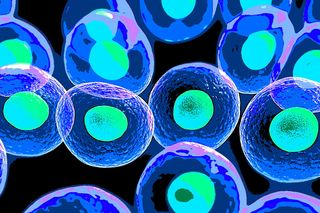
New Stem Cell Research Signals the Wane of Cord Blood Banking
But also opens a host of ethical questions.

Recent campaigns to bank umbilical cord blood on the off-chance children will need its stem cells at a later date may soon come to a screeching halt, after a new analysis of research on induced pluripotent stem cells (iPSCs).
Pluripotent stem cells are master cells that can differentiate into any of the body’s specialized cell types; they can turn into a muscle cell, or a neuron, or a cell within the endocrine system, for example. These cells are present only in embryos. After birth, the human body contains adult stem cells — a term used regardless of a person’s age — which are not pluripotent; they are limited to a tissue type, meaning, for example, adult stem cells housed in the liver could only develop into certain types of liver cells, and would not be able to develop into, say, a neuron. Cord blood contains adult stem cells that can differentiate into only blood or immune system cells.
Induced pluripotent stem cells are derived from fully differentiated cells — a skin cell, say — that have been reverse engineered to have the generic potential of embryonic stem cells. And now, a new analysis of existing research has found that not only are typical signs of aging reversed in iPSCs, but the cells derived from both older and younger donors show the same ability to differentiate into specialized body cells; the degeneration experienced for the former during the aging process doesn’t affect their cells’ functionality once turned into iPSCs.
This validates iPSCs as a viable alternative to embryonic stem cells in regenerative medicine, and may even be an improvement as iPSCs, unlike embryonic stem cells, carry no risk of rejection, since they are created from a person’s own tissue. It also reduces the attraction of investing in cord blood banking and vastly expands the range of possible therapies. Published in Frontiers in Cardiovascular Medicine, the study highlights the enormous potential of iPSCs derived from elderly patients to treat their age-related diseases — and indicates future areas of research for this relatively new field.
“As average life expectancy continues to rise, so does the rate of age-related chronic and degenerative diseases,” explains Dr. Nicolle Kränkel from Charité, a medical university in Germany. “Organ replacement and other cell-based treatments could increase longevity and improve the quality of life for elderly people with heart disease, kidney failure and even Alzheimer’s disease. Our analysis of current knowledge on iPSCs indicates that stem cells derived from older patients are suitable for personalized regenerative therapies as well as for modeling genetic disease.”
The analysis revealed that the age of the donor may reduce the efficiency at which a cell can be reprogrammed into an iPSC. However, once generated, the stem cells appear to be fully rejuvenated — with typical signs of aging reversed.
“iPSCs show improved functionality compared to the donor’s regular body cells, and can be differentiated into mature body cells with a similar efficiency to younger stem cell donors,” Kränkel says. “This means that stem cells from an elderly patient can be developed into other cells and returned to the patient for treatment.”
Despite this promising conclusion, it is still a matter of debate as to whether cells from older donors have accumulated more damaging mutations due to aging, than those of younger donors, mutations that may carry over into the iPSC.
“This seems logical,” says Elisabeth Strässler, co-author of the study. “There is also the issue of whether such mutations persist during the transformation to stem cells, or whether they are repaired.”
Other important questions also remain unanswered.
“The field of iPSC research is still rather ‘young’ and more research is necessary. This includes whether iPSC-derived cells might form tumors once transplanted back into a patient; consensus on which tests should be mandatory for assessing genetic stability and stem cell function; and defined protocols to better compare results from different labs,” Kränkel says.
As do certain ethical questions. iPSCs have been seen by the research community as a more ethical approach to stem cell research and treatment than embryonic stem cells because they do not involve the creation — and destruction — of a human embryo to harvest. Additionally, the donor can give consent for their cells to be turned into iPSCs and used accordingly, whereas an embryo cannot. But iPSCs open up other ethical concerns: Last year, researchers successfully used iPSCs from the same mouse to create egg and sperm cells, opening up the (very distant) possibility of being able to reproduce entirely by one’s self.
This means that, while the regenerative use of iPSCs has already been proved in a young patient (a boy suffering from a rare genetic disease, in which the skin blisters and tears off, recovered completely after receiving a skin transplant grown from his own gene-corrected stem cells) there is still a long way to go, both in terms of research and in terms of regulation, before iPSCs are standard treatment for everyone.
Related


Your Work Anxiety May Be Helping You Perform Better
